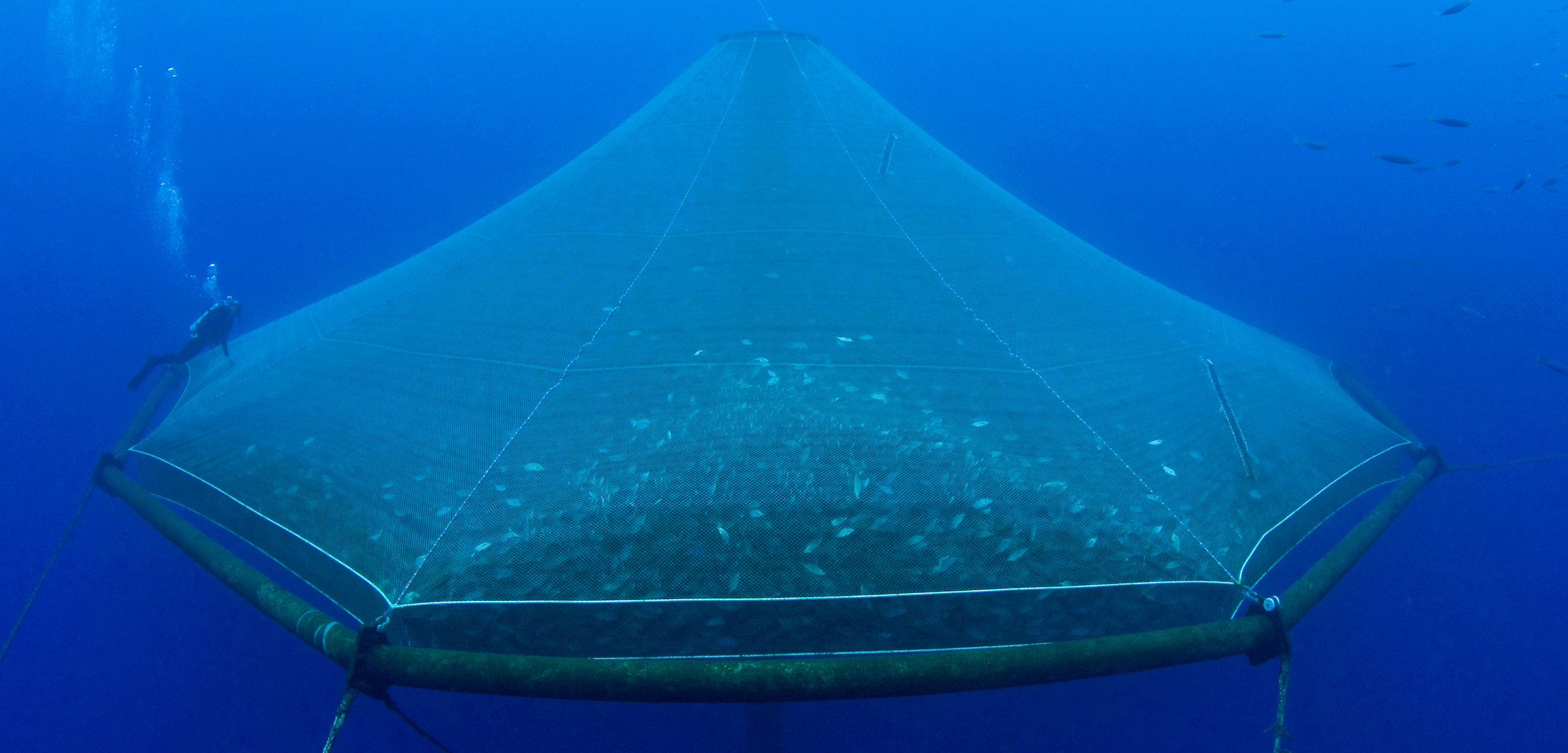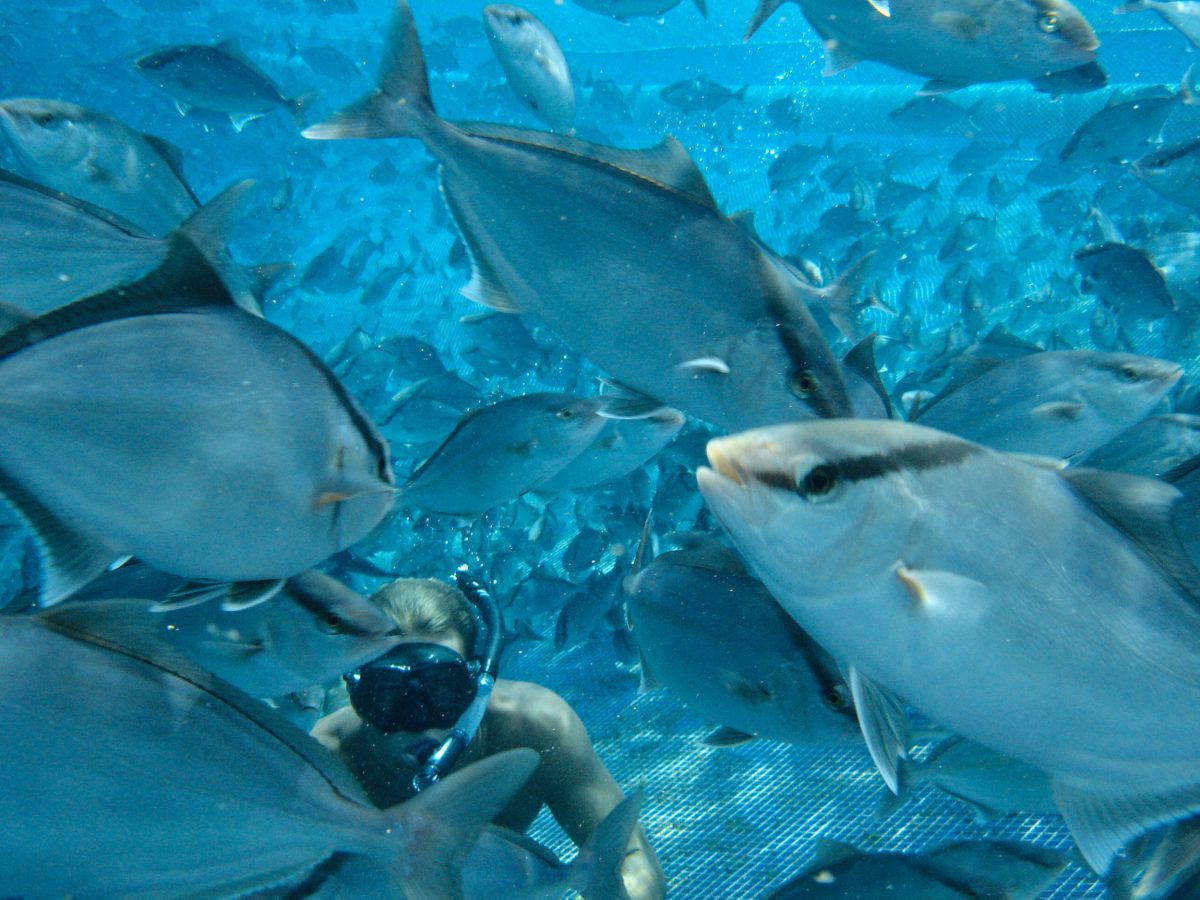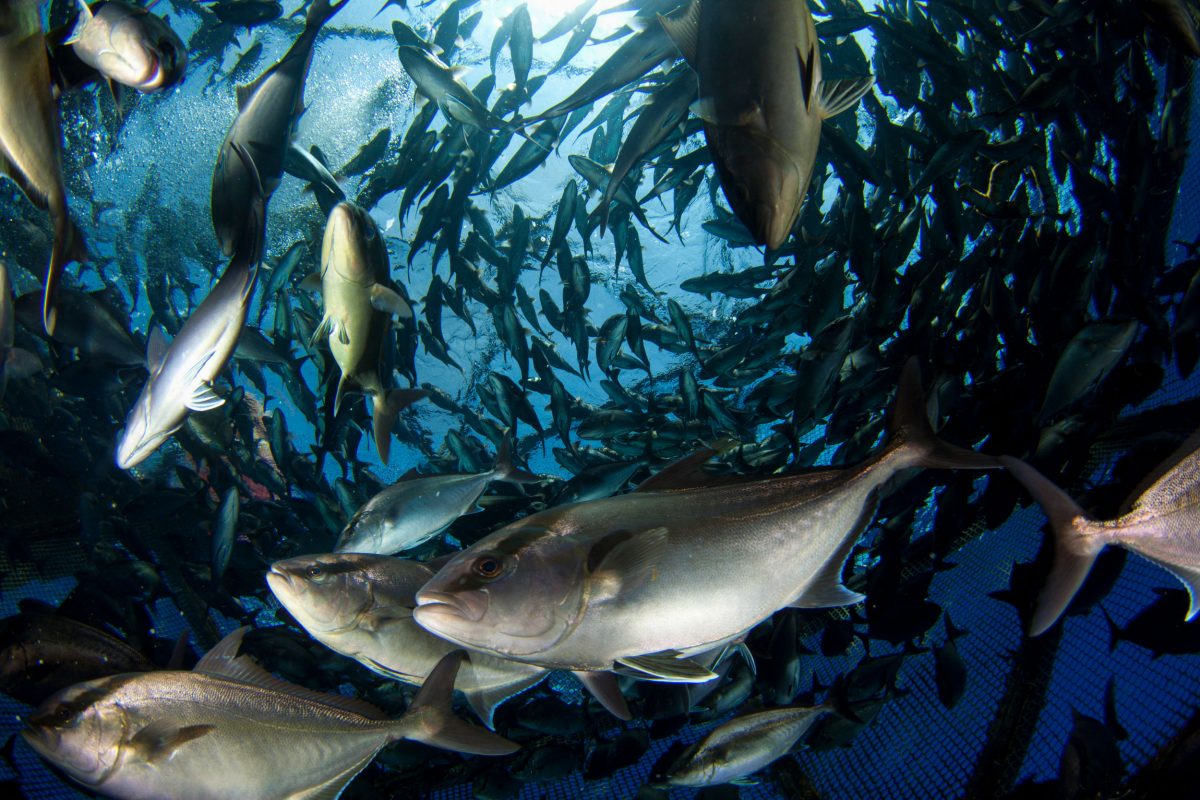Show Me the Money Fish
Aquaculture innovation is driven by a desire for profit, sustainability, and a delicious meal. Can the right marine fish satisfy all three?
Article body copy
This article is also available in audio format. Listen now, download, or subscribe to “Hakai Magazine Audio Edition” through your favorite podcast app.
Pastor Kaunaloa Boshard has come to deliver a blessing. He is wearing a Hawaiian-print shirt and has the implements of his work—several folded palm fronds, a hunk of salt, and a few splashes of water in a wooden bowl. Behind him, a leafy maile lei spans the threshold of a brand new sheet-metal building, less than 100 meters from the crashing waves of the Pacific. This is the grand opening of Hatch, an investment firm that provides seed funding and mentorship to help innovative aquaculture-related start-ups get their sea legs. Boshard expounds on the importance of their mission: “The Hawaiians were doing this way long ago, sustaining hundreds of thousands of people,” he says, as the crowd of believers in flip-flops forms a semicircle around him. “I am thankful for any type of endeavor that takes into consideration the care of our resources and helps feed the world.”
Hatch has offices in Norway, Singapore, and now, here, on the campus of the Hawaii Ocean Science and Technology Park, a place that’s been touted as the Silicon Valley of aquaculture. Situated on a tongue of black lava extending from the lower flanks of the Hualālai volcano on the Island of Hawai‘i, the state-funded campus where Hatch is opening shop looks like an outpost on another planet, with clusters of prefabricated buildings, networks of pipes, and outdoor tanks. More than 40 companies are already based here, breeding oysters, abalone, even octopuses. That’s just the beginning. If there’s an opportunity in every crisis, then the collapse of the world’s fisheries offers profits the size of a supertrawler. The global market in saltwater and freshwater fish will be worth US $275-billion by 2025, according to one industry report. The biggest prize awaits whoever can raise those creatures at the top of the marine food chain—the tunas, the snappers, the groupers—the fish we most want to eat and that the open ocean can no longer adequately provide.
By 2050, the Earth’s population is estimated to grow to nearly 9.7 billion people, and the demand for animal protein is expected to double. Hatch works with about 10 start-ups at a time—40 to date—and each team hopes to find its niche developing technology and products for high-value aquaculture initiatives that will be feeding the world of the future. Or at least they’ll be feeding those consumers who can afford their offerings. The innovations so far have included a warning system for disease outbreaks; a microalgae factory; and a way to moor cages in rougher, offshore waters—the zone that’s considered the final frontier for aquaculture. Moving aquaculture into offshore waters is an imperative considered as crucial to these techno-futurists as colonizing Mars is to certain Silicon Valley types. “This is about us as people providing for other people,” Boshard says grandly, as he asks us all to join hands in a prayer.
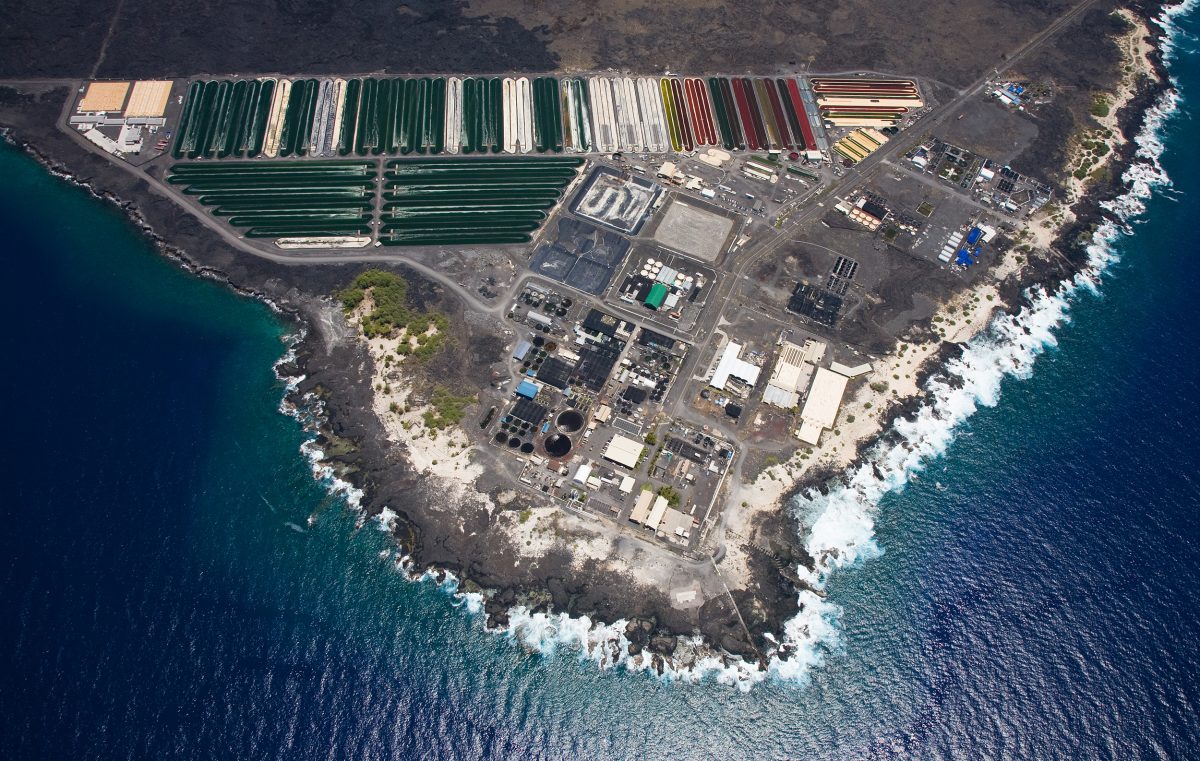
The Hawaii Ocean Science and Technology Park in Kailua Kona on the Island of Hawai‘i is a hub for environmentally minded innovations related to ocean science, including within the field of aquaculture. Photo courtesy of NELHA
After we head inside to dine on a sumptuous poke of farm-raised fish, Mike McCartney, who leads the state’s economic development office, trumpets that Hatch is not just about feeding mouths or creating jobs, but “creating world peace.” Moritz Müller, Hatch’s marketing head, tells those assembled that his job is a “very easy one” because the company’s story is so positive. To hear it from these aquaculture believers, the future of the planet depends on us doing for the oceans now what farmers and ranchers have been doing on land for millennia. But also: not doing to the ocean what farmers and ranchers have done to the land. That means not destroying ecosystems, not pumping livestock with antibiotics, not polluting waterways, not spraying pesticides on crops, not exterminating native species, and not spreading invasive ones.
Just offshore, I can see two circus tents of mesh bobbing in the water. Each one is about 30 meters in diameter. Owned by another company based here, they are the tops of cylindrical net pens filled with more than a million dollars’ worth of fish, the same type of fish that we’re eating. In 2017, an endangered Hawaiian monk seal slipped inside one of the pens that had been opened to release a shark. The seal got trapped inside and drowned. It was a learning experience, and the company has tightened its procedures since then. But imagine the potential impact a suite of new technologies could have if deployed on a global scale in our oceans by actors with less stellar reputations, seeking the quickest returns on their investments. Will they run all the right tests and make changes to protect the environment? Will their employees be properly trained in best practices? Will they abide by local laws? Hatch’s top-billed sponsor happens to be the agribusiness giant Cargill, whose Brazilian soybean purchases have fueled the devastation of tropical forests. Everything we’ve done wrong on land has already been done, in one form or another, with industrial salmon farms that hug the coastline in Norway, Chile, and Canada. What I’m saying is that there are so many ways that moving fish farms deeper into the ocean could go horribly wrong.
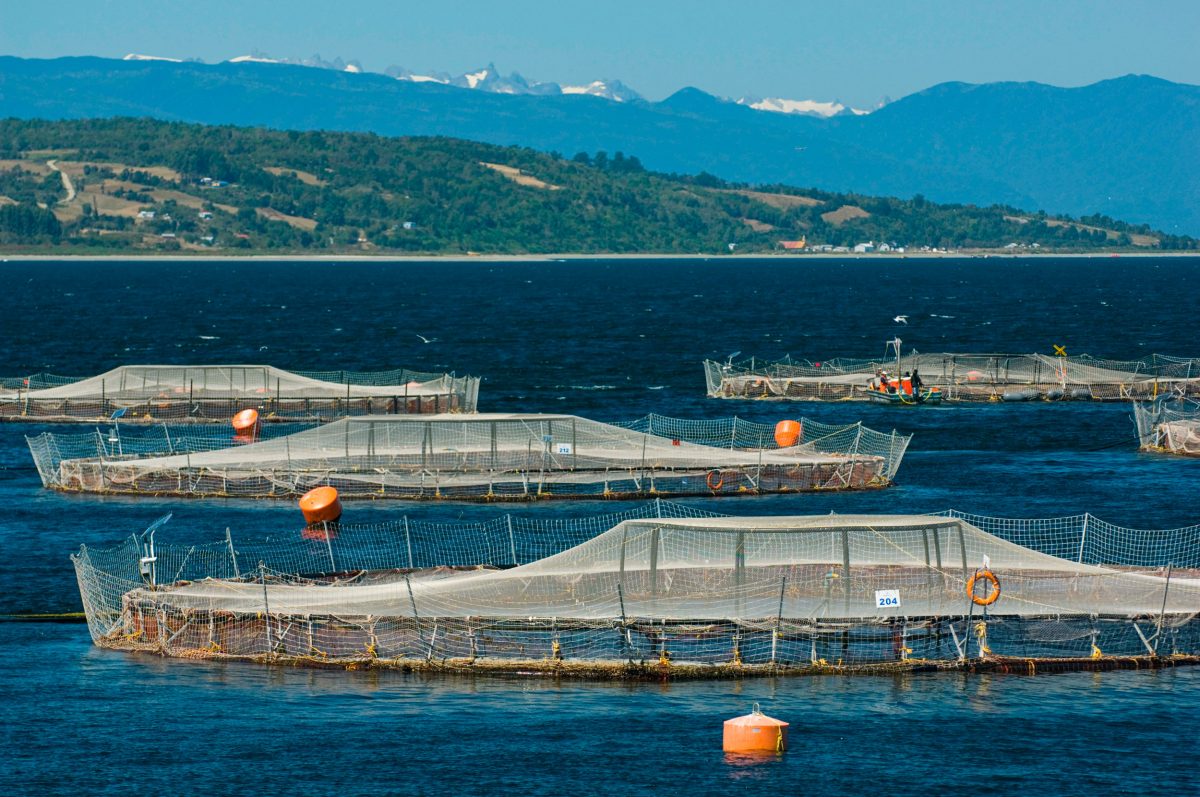
Aquaculturists seeking to develop marine fish for the mass market can learn from the salmon farming industry, which is heavily criticized for damaging sensitive nearshore ecosystems. Photo by Kevin Schafer/Alamy Stock Photo
And that, in a nutshell, is the dilemma that those of us who care about the environment—and about our health—are facing. Conservationists and nutritionists lecture us about giving up red meat in favor of fish. Two servings a week, they say. And also we should be eating down the food chain, choosing forage fish like sardines and anchovies. But guilt is among the least persuasive forces in the market. You know what one of the most persuasive is? Desire. That’s why all pieces of this offshore aquaculture pipe dream—the sustainability, the sustenance, and the profits—depend not only on good intentions but also on finding the right fish to make it a reality.
On the day after the Hatch launch, I return to the campus to hunt down Neil Sims, sort of the Bill Gates of offshore aquaculture, except for the billionaire part. He’s not employed by Hatch, but he has served as a mentor in the program. It was Sims who had invited me to join the festivities, because the world of Hawaiian aquaculture is a small, congenial one, and he’s one of the silverbacks around here. The fish I had eaten as poke the day before—light pink and fatty with a bite as firm and nearly as satisfying as fresh tuna—would not have existed were it not for Sims.
The fish, known locally as kahala, was prone to accumulating parasites and toxins in the wild, making it an unpopular catch among fishermen. But nearly 20 years ago, Sims figured out how to breed and raise kahala in captivity, rebranding it Kona kampachi. Nearly 1,000 tonnes are now farmed each year by two companies in Hawai‘i and one in Mexico, which Sims cofounded or has licensed technology to. Fish are airlifted fresh to the United States and Canada, where the retail price is around US $40 per kilogram. Sims has a fourth pilot farm in the works 64 kilometers off the coast of Florida in the Gulf of Mexico—though it’s being challenged at every step by a coalition of environmentalists and fishermen. COVID-19 has hit the whole seafood industry hard, particularly branded fish like Kona kampachi, which is targeted to the white-tablecloth and sushi markets. But Sims and his team continue to fine-tune Kona kampachi production along with their other efforts while keeping separate research teams in their coronavirus “bubbles.”
When I find him, he is hunched over his computer at the world headquarters of Ocean Era, a musty, one-room office with a scuffed-up carpet and a wall filled with 15-year-old newspaper clippings. (“‘Guilt-free’ fish farming arrives” reads one from the Seattle Times.) An Australian in his 60s, Sims offers me a cup of tea and turns off a dehumidifier rumbling under a marked-up whiteboard. The building is cooled by seawater piped in from 914 meters below the ocean’s surface, which is great for energy efficiency but only adds to the tropical humidity.
Like many aquaculture evangelists, Sims came to fish farming after growing jaded at the state of the world’s fisheries. “I’ve seen enough out there in the ocean to put my hair on end,” he tells me. After getting a marine biology degree in the 1980s, he joined the Australian Volunteers Program—sort of the Peace Corps Down Under—and landed in the Cook Islands, where he taught science classes. Sims had the restlessness gene that so many Australians I’ve met possess. After bumming around the United States and Mexico for five months, he returned to the Cooks at the age of 23 and told the marine resources minister he was willing to work “for food and scuba tank fills.” Excellent, the minister replied. Sims would lead the country’s fisheries research.
Sims was eager to improve the livelihoods of the 17,500 citizens spread over 15 islands, many of whom depended on traditional fisheries practices. Palmerston Atoll had a small, but sustainable, parrotfish fishery. Locals would create barriers out of coconut fronds and drag them across the reef to corral several thousand kilograms of fish—just enough to fill the hold of a 17-meter ice boat that came through every three to four months.
Development happened, as it does in such places, with a bang. An ambitious islander got himself a blast freezer and a vacuum packer. Restaurants in the capital of Avarua on the island of Rarotonga couldn’t get enough of his high-grade fillets. Sims needed to see what was going on. “By the time we got our research team out to the island,” he says, “the fishery was over.” The parrotfish were gone.
Experiences like that got Sims brainstorming about ways to rebuild marine stocks to benefit locals. The South Seas used to be famous for its pearl industry, but the oysters had largely been cleaned out in the 1950s. He set up a research program to monitor oyster populations, and started evaluating the growth of farmed oysters that had been collected as larvae, known as spat. He also played around with relocating spat to marine reserves and areas where populations had been depleted, though those efforts were unsuccessful.

Before Neil Sims became engaged in aquaculture, he led fisheries research in the Cook Islands during his 20s. Photo courtesy of Neil Sims
By the time his stint in the Cook Islands came to an end, Sims understood that to build a pearl industry and keep it viable long-term, workers needed access to commercially produced spat they could use to seed their farms. With a grant from the United States’ National Science Foundation, he and another marine biologist, Dale Sarver, tried to produce black-lip pearl oyster hatchery spat in Hawai‘i. They were successful enough that they started a company together. But, before long, they had fallen behind Chinese businesses that were producing pearls from freshwater mussels and doing it cheaper than Sims and Sarver ever could.
Meanwhile, they watched with horror as the world’s great fisheries, like North Atlantic cod and Mediterranean bluefin tuna, were collapsing. “It felt like we were playing in trinkets and baubles,” Sims says of pearl farming. “At some stage, our kids are going to look at us and ask, What did you do in the war?”
We’ve split atoms. We’ve synthesized life. We’ve built robotic submarines that dive to the deepest parts of the ocean. And yet, we’re sending tens of millions of brave men and women out every day to track, chase, and kill wild animals for our dinner plates. Not only is fishing still one of the most dangerous jobs on the planet but all the technology we’ve thrown at it since the Second World War has led to an increase, rather than a decrease, in the effort it takes to reel in a tonne of fish. We’ve gotten really good at catching fish, not so good at replenishing their stocks. The story of modern-day fishing is the Green Revolution playing in reverse.
Today, the world is eating a lot of farmed fish, but little is coming from the ocean. According to the Food and Agriculture Organization of the United Nations, aquaculture accounts for about half of the world’s seafood production, and 62.5 percent of farmed food fish is raised inland. That’s mostly from shrimp farms and freshwater ponds filled with carp, tilapia, or catfish. Given the choice, however, most consumers will go with something more indulgent—and likely worse for the planet. “Nobody goes to a sushi bar and orders carp. Nobody goes to a steakhouse and orders catfish,” Sims says. “It has to be a fish that is arresting.”
For the last 30 years, the high end of fish farming has been dominated by Atlantic salmon, a $15.4-billion industry. Atlantic salmon has become one of the most profitable fish to grow and is slightly better than chicken in terms of how well it converts feed into body mass. But because salmon are raised in calm nearshore environments, such as fjords, bays, and inlets, the industrial salmon farming industry has transformed some of the most sensitive and valuable aquatic ecosystems on Earth into a giant toilet. The waste piles up like in an aquarium during a power failure. Farming salmon in confined spaces also makes them more susceptible to outbreaks of diseases and parasites, such as sea lice, which can then spread to wild fish using the same habitats. And because salmon return to their natal streams to breed, they have many genetically distinct populations, which can be harmed when they interbreed with selectively bred farmed salmon that escape pens—not an unusual occurrence.
Atlantic salmon must be raised in cold water, such as in this Norwegian waterway, which Sims says limits their utility as an aquaculture product. Video by cookelma/Pond5
For Sims and other experts, the greatest limitation of using salmon in aquaculture is that they are simply not a global solution. They must be raised in cold waters, which is one reason why they still account for only four percent of the world’s fish farms. There’s also not a lot of space left close to shore for new farms that won’t be challenged by environmentalists or by locals who don’t want their views marred. Chilean farms in the Tenth Region—an administrative division—are packed so tightly together that they’ve been ravaged by infectious salmon anemia. Norway has cut back on issuing permits for nearshore farms while incentivizing offshore developments.
Though there’s no universal definition of offshore aquaculture, as you get just a couple of kilometers from the coast, the deeper water circulates at a faster rate, diluting waste. The impact of farms on water quality becomes largely undetectable at distances beyond about 90 meters from the pen. Fish, for one reason or another, also seem to grow faster the farther offshore they are, though the data on that is limited. To fill such distant pens, it also makes sense from an ecological point of view to switch from salmon, which maintain ties to their natal streams, to wholly marine fish, which exhibit more genetic mixing over a larger geographic area and population size. Because their populations are less genetically distinct, marine fish escapees pose minimal risk to their wild relatives.
But there are good reasons why there hasn’t been much success at raising other ocean-going species. Though salmon spend most of their adult lives at sea, they are, at heart, a river fish. They lay a few thousand eggs at once, four to five millimeters in diameter, the two-eyed embryo surrounded by pink yolk. That makes them hardy and easy to work with in captivity. And by the time they consume their yolk sac, the fry are ready to eat dry food.
Most marine fish, by contrast, broadcast their eggs by the tens of millions—poppyseeds with a miserly droplet of oil in each one—and the only way hatchlings survive is by eating just the right kind of microscopic prey, such as rotifers and copepods. Keeping these tiny fish hatchlings alive in captivity requires getting the environmental conditions just right and being able to efficiently produce such short-lived prey in sync with fish growth.
By 2001, Sims and Sarver had given up on pearls and started thinking about feeding the world. They wanted to see just how tough it would be to breed and raise ocean fish from eggs, trying to find a worthy competitor to farmed salmon. With a grant from the US Department of Commerce, they collected nine different species off the coast and brought them to the Hawaii Ocean Science and Technology Park. Along with developing hatchery techniques, they also measured the fishes’ rate of growth, their efficiency at turning feed into flesh, and their propensity toward cannibalism—a no-go when you’re cramming fish into close quarters. When the fish got to be about half a kilogram, Sarver, the gourmand of the two, would take them home for a taste test.
The flesh of the mahimahi, they found, was too soft. And keeping mahimahi in tanks was like “trying to farm gazelles.” They would ram the side of the tank so hard they would break their necks, or they’d eat so much food their stomachs would burst. Maybe you could selectively breed that out of them, but Sims wanted to avoid some of the pitfalls of the salmon industry. He wanted a hatchery that produced fry with nearly the same genetics as their wild relatives, minimizing the impact of any potential escapees. Next up was the peacock grouper, which tasted great but grew like a tortoise—just 100 grams after six months. Then, there was the giant trevally, a popular sport fish that gets up to 80 kilograms in the wild. It grew quickly but not efficiently.
One morning, Sims was scrubbing a tank in the yard, when Sarver came running in waving his arms. The night before, he had taken home kahala. It had performed well in the tanks, but it had a reputation for being a “trash fish.” If you sliced a wild one open, you were likely to find a big, ugly worm tunneling its way through the meat. Kahala had also been implicated in cases of ciguatera poisoning from an algal toxin that sends unlucky diners wobbling off to the restroom.
Sarver’s verdict: “It tastes amazing.”
“Really?” Sims said. Sims pulled another out of a tank, thumped it on the head, sliced it up, and ate it raw. It was phenomenal, rich and buttery like yellowtail, a distant relative, but with a firmer bite. While wild kahala were sleek creatures with a fat content of just a few percent, the farm-raised fish had a plumper, football-shaped body with up to 30 percent fat—on par with salmon or the best farmed tuna. Since they are raised from eggs, they can’t be exposed to ciguatera or infected with worms.
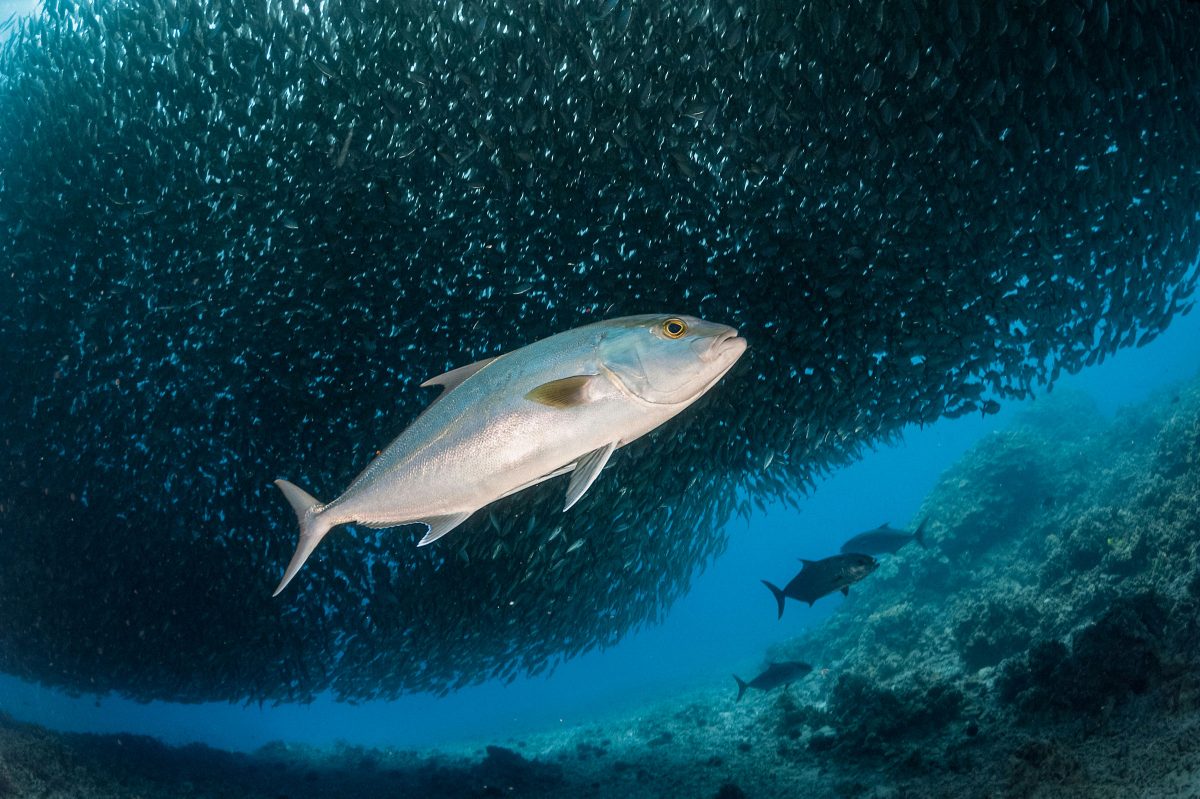
Kahala—the fish branded Kona kampachi—is unpopular with fishers because, in the wild, it can be prone to having parasites and toxins. Photo by Doug Perrine/Blue Planet Archive
Sarver and Sims decided to rebrand the fish to shed the negative associations locals had with kahala. A Honolulu chef suggested Kona kampachi, using the Japanese name, as the duo’s first goal was to break into the tradition-bound world of sushi with a sashimi-grade fish. With financing from Thomas McCloskey, an investor in Horizon Organic dairy, among others, they founded Kona Blue in 2005 and started commercial kampachi production. Top chefs around the country added it to their menus and high-end retailers soon followed. At the time, there was still no formal certification system for farmed fish, but Whole Foods visited Sims’s operation and agreed to stock kampachi, burnishing its eco-credentials.
In 2008, the Monterey Bay Aquarium began evaluating the sustainability of kampachi as part of its Seafood Watch program. Sims knew he had a problem. Every kilogram of fish he produced required over two kilograms of fish meal and fish oil obtained from wild fisheries, such as the Peruvian anchovetta fishery. In order to nudge kampachi up from the red-flagged “avoid” category into the amber “good alternative,” that fish-in-fish-out ratio needed to be two to one or lower.
Sims decided to replace some of their fish meal with poultry meal—a chicken byproduct. He knew that once he did, Whole Foods would stop buying his fish. So would a number of his chefs. He was breaking an unspoken taboo, a sacred standard that at least some people hold for our ocean fish, which is that it’s somehow unnatural to feed them land-based meat. Or, at least, it threatens to taint the purity of the oceans with the stench of factory farming. It’s not a concern that Sims himself shares. He’s a pragmatist to his core, which is fantastic when you’re trying to save the world. Not so much when you’re trying to market a product to the masses. Sims, of course, is trying to do both.
Kona Blue faced other problems as well. Shipping to the mainland was expensive, and production needed to triple in size for the business to become profitable. When the financial markets crashed in 2008, Sims’s main investors pulled out, and he was forced to sell off the commercial side of the operation, which is now run by a company called Blue Ocean Mariculture.
In the aftermath, Sims founded Kampachi Farms to continue doing research related to various challenges and innovations in aquaculture. Although water-quality measurements had identified no impacts from his commercial-scale operation close to shore, he knew it was time to move into deeper water. In 2012, he tested a drifting cage known as the Velella, keeping a boat tethered to the cage to occasionally tow it back into position. Later, he anchored the Velella in 1,800 meters of water. That operation, still in development about 10 kilometers offshore of Hawai‘i, has been taken over by a company called Forever Oceans.
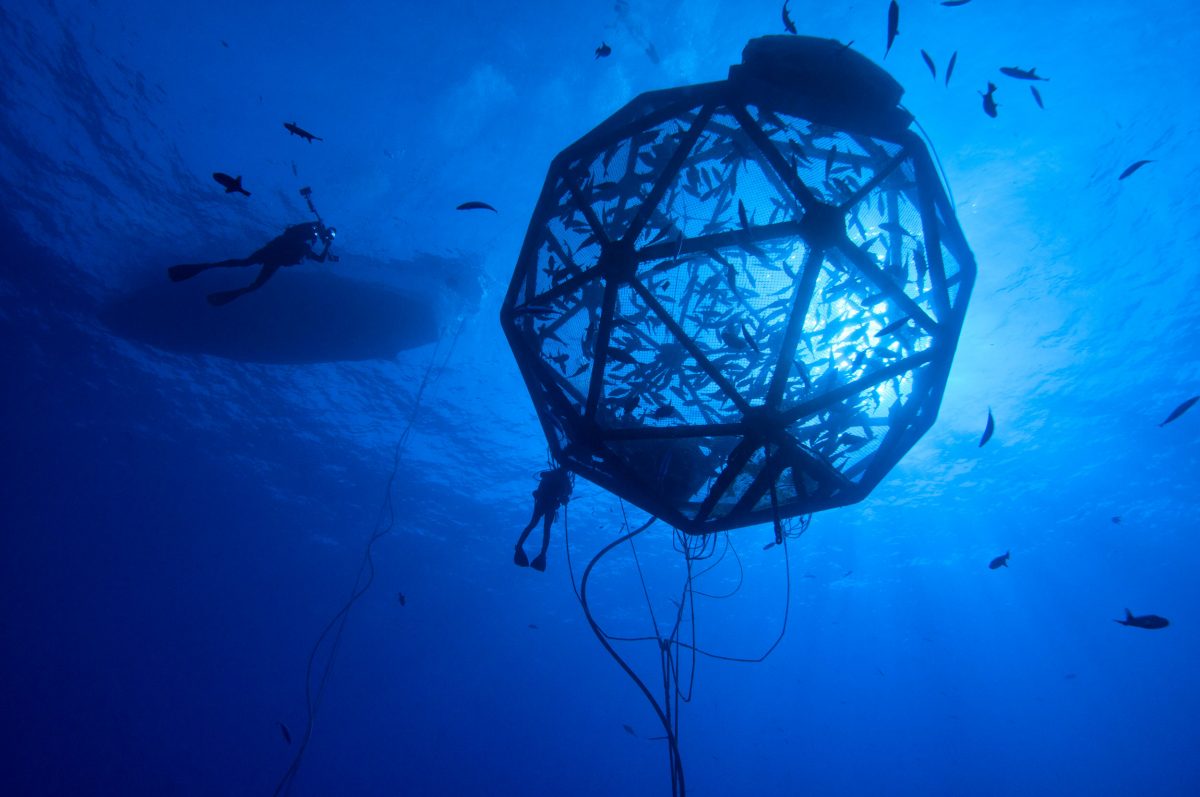
Sims tested out this drifting cage, known as the Velella, for offshore fish farming in 2012. Photo by Rick Decker
In 2013, Sims entered the commercial realm again, establishing an offshore kampachi farm in Baja California using local broodstock. Kampachi today are raised on a pellet feed free from antibiotics and hormones. It takes about a kilogram and a half of feed to produce a kilogram of kampachi, a bit better than chicken and a little worse than salmon. The fish-in-fish-out ratio in these pellets is now down to 1.1 to one, thanks in part to the recent availability of corn and pea proteins. But the way that ratio is calculated doesn’t take into account the fish trimmings coming from the Alaska pollock fisheries. Once used to power on-board diesel generators, the trimmings from pollock fillets are now processed into fish meal and fish oil, which account for half of the fish content in the kampachi diet. “It’s a bonus,” Sims tells me, though it seems a wee bit like sleight of hand to me.
But it’s better than the alternative. Sims points out that it takes 10 to 15 kilograms of anchovetta to produce a single kilogram of the typical marine fish in the wild. Eating wild fish at the top of the food chain is, in his moral universe, a luxury that is hard to justify. “There’s a conflict between the desire for wild ecosystems and the need to feed nine billion people.”
Even academics with few or no ties to the industry consider the case for offshore aquaculture to be persuasive. “It’s looking like a really feasible way to lower the potential impacts and increase production,” says Halley Froehlich, a fisheries ecologist and aquaculture professor at the University of California, Santa Barbara. In a paper published in Nature Ecology & Evolution, Froehlich and her colleagues estimated the amount of the ocean available to fish and bivalve farming. They developed an index of how well different species would grow at various temperatures and then ruled out areas that were protected, are too deep to anchor cages, or are allocated for other uses such as oil production. In the end, they estimated that 12 million square kilometers are potentially available for farming fish and bivalves—enough to produce 100 times the amount of seafood we are currently eating. Granted, some of these areas would put aquaculture in conflict with energy infrastructure or coral reef conservation, or would present economic hurdles because of distance to market, for example. It would take aquaculture initiatives covering only an area of the ocean smaller than Lake Michigan to replace all of the seafood captured by wild fisheries.
Most countries could supply their nation’s seafood consumption for the conceivable future with farms occupying just a few percent of their exclusive economic zone. China is already a leader in this area. In 2017, after the engineering firm Qingdao Wuchuan delivered an oil platform–sized fish cage—capable of containing about 1.5 million fish—to the Norwegian salmon company Ocean Farming, it announced it would deploy several more in the South China Sea, a region where experts have long expressed concerns about a lack of regulatory oversight. At the same time, there isn’t a single offshore finfish farm anywhere in the continental United States today—a country that imports more than 80 percent of its seafood.
It’s not for lack of trying. Resistance comes from fishers and from eco-purists who believe that the only place we should be growing fish is in recirculating tanks in the middle of Saskatchewan or Oklahoma—anywhere, basically, where a fish will die if it tries to escape. Last year, the New Orleans-based Recirculating Farms Coalition, an offshoot of the environmental group Food and Water Watch in Washington, DC, won a lawsuit against the National Oceanic and Atmospheric Administration, blocking it from issuing permits for Sims to raise kampachi in the Gulf of Mexico. The same group had previously blocked Sims’s expansion in Hawai‘i back in 2011. The question of which agency has the authority to issue aquaculture permits in federal waters remains contentious, though. Sims already has permits from the US Coast Guard and the State of Florida. Last year, the Environmental Protection Agency issued Sims with a draft permit, which would allow untreated waste and excess food to spread from the mesh pen into the ocean. That permit is now being challenged by Sims’s foes, and he expects the dispute to continue playing out in court.
Land-based recirculating farms have their advantages, such as being close to the markets they serve. The Norwegian firm Atlantic Sapphire is building a $350-million salmon farm outside of Miami, Florida, and other major salmon operations are in the works in Maine and California. The problem with recirculating farms is that they require 24-hour electricity and the attendant greenhouse gases that come with it. A power failure or a viral outbreak can be devastating. Even without such disasters, the expenses make it hard to be profitable. Of the 61 recirculating fish farms that were developed in the United States over the past 20 years, only 14 were still in operation by 2016, according to data compiled by Josh Goldman, the founder of Australis Barramundi.
“The fish are entirely dependent on technology for life support,” Goldman says. His company began by raising barramundi, a type of sea bass, in recirculating tanks in Massachusetts but has sold that operation and is now focused entirely on net pens in a bay in Vietnam. Australis is not in the open ocean, but it is still in deeper waters than is typical for Southeast Asia. It is the first farmed marine fish to receive Seafood Watch’s “best choice” rating. “It became clear to us that to really address the broader market and achieve the highest quality, we were going to be better served doing it within the fish’s native environment,” Goldman says.
Other pioneers have also been leaning toward offshore systems. Greece, Italy, and other Mediterranean countries have long raised sea bream in pens less than a kilometer offshore, but plans are in place for a 2,000-tonne-per-year farm about 15 kilometers off the coast of Israel. Cobia, a firm, white-fleshed fish that can be sliced and served as sashimi, is a docile, wide-ranging tropical fish that can be found as far north as Massachusetts in the summers; in Panama, a company called Open Blue stocks cobia in what has been called the world’s largest offshore fish farm. Cobia has also been raised in Taiwan, Puerto Rico, Mexico, and Vietnam, where it can grow to five kilograms in just a year.
The question is whether the companies serving up cobia or kampachi can ever feed the masses, or if they are just helping the wealthy feel good about themselves. Dane Klinger, the head of aquaculture for Conservation International, says that innovations are often introduced to the market with the most expensive products. “As farmers get better, and they’re able to lower the production costs and get more efficient, we’ll start to see benefits across the value chain.” Goldman says that barramundi now falls in the middle of the price spectrum compared with other fish for sale in the supermarket. “We are not feeding people living on one or two dollars a day,” he says, “but producing something that is broadly affordable by the global middle class.”
Yet, none of these fish, including kampachi, are particularly well known in the marketplace. “I thought the production would expand more rapidly than it has,” Sims admits. When he makes his kampachi pitch to potential investors, they agree that it’s a great fish, but then they’ll ask, “What about farming bluefin tuna?” Sims just shakes his head.
Even though the Japanese have boasted of developing a hatchery using captive-reared bluefin tuna broodstock, he doubts that the species will ever be a sustainable fish to raise in captivity at scale. The problem is that it’s a finicky, warm-blooded fish that burns calories like rocket fuel as it jets across the cold ocean. Because of its physiology, it simply will never be that efficient at turning feed into food.
Sims and I don wide-brimmed hats and walk outside to the lava field, where seawater is piped directly into dozens of large black tanks covered in black shade cloth. When he lifts the mesh on one tank, kampachi are visible orbiting in fast circles. The water begins to roil as they breach the surface. “They’re hungry,” he says.
In one of Sims’s latest experiments, he has raised kampachi on a fish meal–free diet, replacing it with up to 30 percent spirulina algae. The fish grew just fine. The problem is that spirulina costs up to $10,000 a tonne compared with $2,000 a tonne for commercial fish meal. Prices will have to go down. Over the years, Sims has also worked to incrementally reduce the amount of fish oil in the kampachi diet from 18 percent, to nine percent, to four percent. With omega-3 algal oil produced by a Dutch company called Veramaris, he has now succeeded in completely omitting fish oil from the diet.
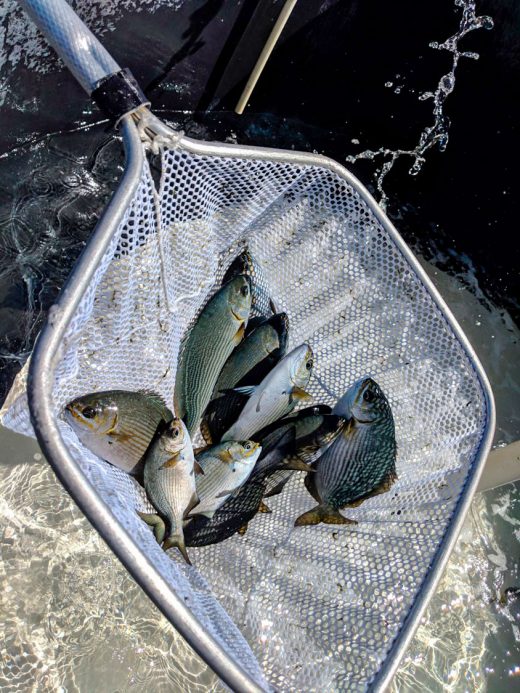
Nenue (also known as rudderfish or chub) is another marine fish that Ocean Era is developing for aquaculture. Photo courtesy of Ocean Era, Inc.
Even with these improvements, Sims has always known that kampachi is not the fish that will feed the world. To raise it sustainably will always require expensive pellet feed with the nutrients fine-tuned to optimize growth. Even if the price of kampachi meat dropped to $20 a kilogram, that’s still far more than a person in East Africa or Southeast Asia could afford.
Before I leave, Sims directs me toward another tank, where I can see a darker fish, lugubriously circling. “Nenue,” Sims says. Known as sea chub or rudderfish in other parts of the world, it’s a herbivorous fish that survives on seaweed in the wild. Though it is slower growing than kampachi, its fat content can be as high as 28 percent. Hawaiians eat nenue in traditional poke, but it has a strong flavor of seaweed and many people find it unpleasant. In the Gulf of Mexico, it feeds on sargassum, making it taste pretty gross.
With the right diet, however, Sims says it tastes like snapper. Nenue has the promise of being the tilapia of the seas—a cheap, efficient, mild-tasting fish that really could be raised off the coast of even the poorest, most remote villages. It requires no fresh water. No land. No nutrients. Just the open sea and a steady supply of seaweed. Sims envisions seaweed farms side by side with nenue operations, disconnected from the global markets and offering food security for the masses. The only problem? There isn’t much money in it—at least not yet.
Sims has been raising nenue in Hawai‘i on grant money for almost five years, but he still has a lot of work to do, improving hatchery production and identifying the optimal algae to raise it on. “It’s taken us 20 years to get kampachi from where it was to where it is now,” he says. He performs the arithmetic with his own life, projecting how many more years he has to succeed with nenue. “It’s a little frustrating to have this fish that has so much potential and to have it languishing here.” Sims doesn’t linger too long with this wistful thought. He’s too much of an optimist for that, and I’ll later hear that he’s gotten some new investor interest. But at the moment, he just replaces the cover on the tank and hurries on excitedly, crunching across the black lava and wending his way through rows of burbling glass aquaria.
Read the next story in our special editorial package on aquaculture: “Taking the Fish Out of Fish Feed”

